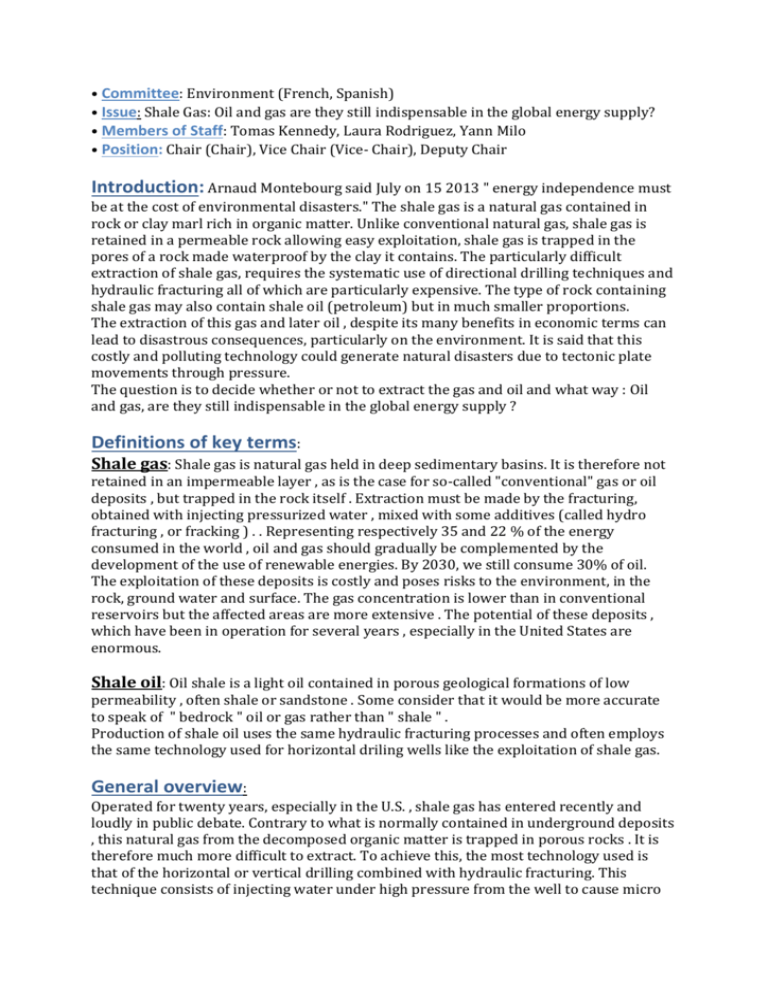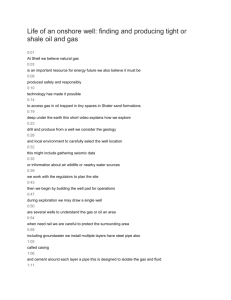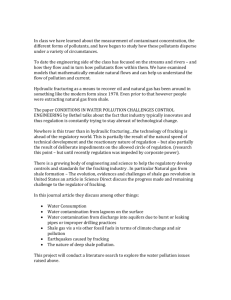Issue: Shale Gas
advertisement

• Committee: Environment (French, Spanish) • Issue: Shale Gas: Oil and gas are they still indispensable in the global energy supply? • Members of Staff: Tomas Kennedy, Laura Rodriguez, Yann Milo • Position: Chair (Chair), Vice Chair (Vice- Chair), Deputy Chair Introduction: Arnaud Montebourg said July on 15 2013 " energy independence must be at the cost of environmental disasters." The shale gas is a natural gas contained in rock or clay marl rich in organic matter. Unlike conventional natural gas, shale gas is retained in a permeable rock allowing easy exploitation, shale gas is trapped in the pores of a rock made waterproof by the clay it contains. The particularly difficult extraction of shale gas, requires the systematic use of directional drilling techniques and hydraulic fracturing all of which are particularly expensive. The type of rock containing shale gas may also contain shale oil (petroleum) but in much smaller proportions. The extraction of this gas and later oil , despite its many benefits in economic terms can lead to disastrous consequences, particularly on the environment. It is said that this costly and polluting technology could generate natural disasters due to tectonic plate movements through pressure. The question is to decide whether or not to extract the gas and oil and what way : Oil and gas, are they still indispensable in the global energy supply ? Definitions of key terms: Shale gas: Shale gas is natural gas held in deep sedimentary basins. It is therefore not retained in an impermeable layer , as is the case for so-called "conventional" gas or oil deposits , but trapped in the rock itself . Extraction must be made by the fracturing, obtained with injecting pressurized water , mixed with some additives (called hydro fracturing , or fracking ) . . Representing respectively 35 and 22 % of the energy consumed in the world , oil and gas should gradually be complemented by the development of the use of renewable energies. By 2030, we still consume 30% of oil. The exploitation of these deposits is costly and poses risks to the environment, in the rock, ground water and surface. The gas concentration is lower than in conventional reservoirs but the affected areas are more extensive . The potential of these deposits , which have been in operation for several years , especially in the United States are enormous. Shale oil: Oil shale is a light oil contained in porous geological formations of low permeability , often shale or sandstone . Some consider that it would be more accurate to speak of " bedrock " oil or gas rather than " shale " . Production of shale oil uses the same hydraulic fracturing processes and often employs the same technology used for horizontal driling wells like the exploitation of shale gas. General overview: Operated for twenty years, especially in the U.S. , shale gas has entered recently and loudly in public debate. Contrary to what is normally contained in underground deposits , this natural gas from the decomposed organic matter is trapped in porous rocks . It is therefore much more difficult to extract. To achieve this, the most technology used is that of the horizontal or vertical drilling combined with hydraulic fracturing. This technique consists of injecting water under high pressure from the well to cause micro cracks in the rock and thereby release the gas contained therein. Many additives are introduced in large quantities of water used for fracturing sand, biocides, detergents and lubricants. It is the multiplication of drilling areas , and the use of this hydraulic fracturing that raises the most criticism because it presents risks of underground water pollution . Not to mention the gas leaks into the atmosphere and risks of earthquakes ... Environmental issues Due to extraction techniques used, the environmental impact of the production of shale gas is higher than that of conventional hydrocarbons. Hydraulic fracturing in fact requires larger amounts of water than for a conventional drilling: for a well , we injected an average of 10 to 20 thousand cubic meters , equivalent to 4 to 8 Olympic swimming pools . Therefore this requires on site: • Significant water resources during fracturing operations that last a few weeks; And • means for processing the water coming up from the well after injection. Once treated, the water can be reinjected or used for the next wells. Additives are used in very small quantities and at great depths. However, as a precaution, the industry is developing additives from the food industry to replace those used nowadays. Finally, the exploitation of shale gas also causes nuisance for the surface such as : • Noise: the drilling and fracturing last only a few weeks per well, but they are noisy. In urban areas, they may require the construction of noise barriers; • Road traffic: Many trucks carry drilling equipment, sand and sometimes water. Such as noise problems, traffic is limited in time to the phase of production wells; • The number of wells: each well to extract less gas than in conventional generation, we must multiply the number. To limit their space (their " footprint ") , the wells are grouped by 10 or 15 in a single drilling platform , called " cluster ". Note that in the production phase, there remains only the main well (the derrick is removed at the end of each drilling) . The extraction of oil and gas also has many advantages: • BENEFITS DUE TO LOCALY PRODUCED GAS • MORAL AND CIVIC BENEFITS • POLITIC, ECONOMIC AND FINANCIAL BENEFITS • BENEFITS OF INFRASTRUCTURE USE (See more pros and cons in the second webography link) However, new non-polluting techniques to extract gas without damage are being researched. Scientists are trying to develop a new technique of "improved" hydraulic fracturing. Organization and country concerned: Image depicting the viewpoint of countries on the subject: Example global organizations potentially affected: earth System Governance Project ( ESGP ) Global Environment Facility ( GEF) Intergovernmental Panel on Climate Change (IPCC ) United Nations Environment Program ( UNEP) World Nature Organization ( WNO ) World Wide Fund for Nature (WWF) Treaties and Resolutions concerned: • Resolution voted in the European Parliament http://www.usinenouvelle.com/article/le-parlement-europeen-vote-une-resolutionsur-les-gaz-de-schiste. N182358 webography : • http://www.usinenouvelle.com/article/le-parlement-europeen-vote-une-resolutionsur-les-gaz-de-schiste.N182358 • http://en.wikipedia.org/wiki/List_of_environmental_organizations • http://total.com/fr/energies-savoir-faire/petrole-gaz/explorationproduction/secteurs-strategiques/gnc/gaz-schiste-1 • http://www.advres.com/pdf/A_EIA_ARI_2013%20World%20Shale%20Gas%20and%20Shale%20Oil%






